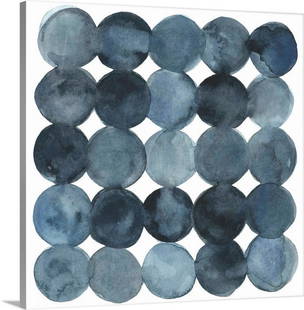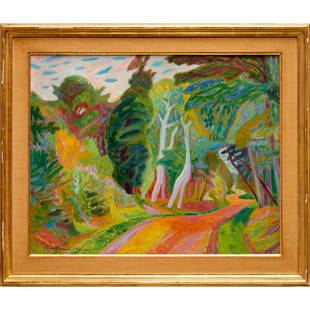
Morris Louis (1912-1962) Blue Pilaster II, 1960
Morris Louis Sale History
View Price Results for Morris LouisRelated Paintings
More Items from Morris Louis
View MoreRecommended Art
View More




Item Details
Description
Blue Pilaster II, 1960
Acrylic resin (Magna) on canvas
83 x 23-1/2 inches (210.8 x 59.7 cm)
PROVENANCE:
André Emmerich Gallery, New York;
Waddington Galleries, London;
Alistair McAlpine, London;
Waddington Galleries, London;
Helen Heninger;
Waddington Galleries, London;
The Trustees of the Chatsworth Settlement, United Kingdom.
LITERATURE:
D. Upright, Morris Louis: The Complete Paintings: A Catalogue Raisonné, Harry N. Abrams, Inc., New York, 1985, no. 303, p. 160, illustrated in color.
It was a seemingly-ordinary visit to New York City in 1953 that redirected the career of 41-year-old Morris Louis and dramatically shifted Abstract Expressionism toward Color Field painting. For 20 years, against the better judgment of his Russian-Jewish immigrant family, Louis led a quiet life as a Cubist painter. Apart from a stint in New York from 1936-1943 designing murals for the WPA, Louis stayed planted in the DC suburb of Silver Springs, participating in exhibitions at the Baltimore Museum of Art and teaching at the Washington Workshop Center of the Arts. Here, his fellow instructor Kenneth Noland, a graduate of the avant-garde Black Mountain College in North Carolina, introduced Louis to the New York art world.
In April 1953, Noland invited Louis to spend a weekend in New York City with his former teacher Clement Greenberg. Greenberg was a famous art critic and champion of Abstract Expressionism. On Saturday, Greenberg took Louis and Noland to several local galleries to see the Abstract Expressionist works of Jackson Pollock and Franz Kline. Louis was mesmerized by his first experience with Abstract Expressionism. Later that evening, the men spent five hours at Helen Frankenthaler's studio and fell captive to her "soak stain" masterpiece Mountains and Sea, whose pours of thinned acrylic on unprimed canvas evoked a lyrical landscape. Greenberg later wrote about this transformative moment in Louis's life and in the history of art:
"His first sight of the middle-period Pollocks and of a large and extraordinary painting done in 1952 by Helen Frankenthaler, called 'Mountains and Sea,' led Louis to change his direction abruptly. Abandoning Cubism with a completeness for which there was no precedent in either influence, he began to feel, think, and conceive almost exclusively in terms of open color. The revelation he received became an Impressionist revelation, and before he so much as caught a glimpse of anything by Still, Newman, or Rothko, he had aligned his art with theirs. His revulsion against Cubism was a revulsion against the sculptural. Cubism meant shapes, and shapes meant armatures of light and dark. Color meant areas and zones, and the interpenetration of these, which could be achieved better by variations of hue than by variations of value. Recognitions like these liberated Louis's originality along with his hitherto dormant gift for color" (J. Elderfield, Morris Louis, exhibition catalogue, The Museum of Modern Art, New York, 1986, p. 13).
In 1954, in the wake of this color epiphany, Louis experimented with the materials and techniques he observed in Frankenthaler's studio and produced his first mature series of work, The Veils. He abandoned the easel and tried various methods of staining unprimed, unstretched canvas in his tiny 12 x 14' studio. First he draped a large canvas over a paint can on the floor and poured paint over the elevated area. Then he tacked the canvas to a stretcher and poured paint from the top and sides. Louis preferred the fluid consistency of an acrylic paint called Magna, developed by Leonard Bocour, whom Louis knew from his WPA days in New York. Magna appealed to Louis because it could be thinned with turpentine; its resin had a glass-like transparency, creating a luminous effect; and its chemical structure forced each layer of paint to bond together, ensuring a smooth, homogeneous surface. For the Veils, Louis poured overlapping bands of Magna from the top of the stretcher. The paint fanned outward toward the edges and puddled at the bottom. He then poured a "veil" of darker color over the bands, further unifying the surface and effecting a mysterious, ethereal quality. He shaped the bands by loosening or tightening the canvas, and finally, as with all of his subsequent series, cropped the composition and stretched the canvas after the painting had been finished.
The Veils are oriented both horizontally and vertically. The "split" Veils reveal bare canvas between the poured bands, and the "triadic" Veils resemble a triptych, as the two braces of the stretcher leave vertical lines that divide the canvas into three sections. While Louis borrowed staining methods from Frankenthaler, he moved beyond her techniques by erasing drawing and landscape elements from the canvases. Indeed, the brilliance of the Veils lies in their insistence upon flat, allover color, rather than three-dimensional tonality, to define painting.
Clement Greenberg played an enormous role in cultivating Louis's success. Not only did he introduce Louis to key Abstract Expressionist artists and dealers, but he also arranged important exhibitions for Louis in New York, including the 1954 "Emerging Talent" exhibition at the Kootz Gallery; a 1957 group show at Leo Castelli Gallery; his first one-man show at the Martha Jackson Gallery; and key exhibitions at French & Company in 1959 and 1960-showcasing 23 Veils. Louis rarely showed his art to anyone (including his wife), but he wholly trusted Greenberg and relied on the critic to help crop, title, and orient his paintings. Greenberg ultimately served as the advisor to the Louis Estate from 1962-70.
In 1960 Greenberg wrote a major essay for Art International, "Louis and Noland," which brought worldwide attention to the two artists Greenberg described Louis's groundbreaking stain technique as a means of giving primacy to color:
"The effect conveys a sense not only of color as somehow disembodied, and therefore more purely optical, but also of color as a thing that opens and expands the picture plane. The suppression of the difference between painted and unpainted surfaces causes pictorial space to leak through-or rather, to seem about to leak through-the framing edges of the picture into the space beyond them." (D. Upright, Morris Louis: The Complete Paintings, New York, 1985, p. 21).
Alternate Artist Spellings: "Louis, Morris"
Condition
The painting is in overall excellent condition. The surface is an acrylic magna wash over raw unprimed canvas. The surface is flat and plane with no visible cracquelure. The cotton duck canvas is in good condition. There are small breaks in the weave in the lower right quadrant. The wood expansion bolt stretcher has one horizontal crossbar and is also in good condition and a proper weight for the painting of this size. The artist's name, date, and painting number (#435) are written in marker along the right side of the wood support. There is also writing in pencil along the top bar including pricing. On the verso top right, the #435 is written in pencil directly on the canvas. The surface has minor discolorations throughout the canvas but most are not immediately noticeable with the unaided eye. There is one light colored ring shaped stain in the lower right quadrant. In my opinion it appears to have been a stain that was cleaned from the surface but because it was directly on raw canvas, it was never fully removable.
Under UV (ultra-violet, Black light) inspection, there is significant variation in color values between the unprimed canvas and paint stained area. The stain in the lower right also fluoresces with significant contrast as does a ring of residual staining from the attempted cleaning.
Framed Dimensions 84.5 X 25.25 InchesBuyer's Premium
- 25% up to $200,000.00
- 20% up to $2,000,000.00
- 12% above $2,000,000.00
Morris Louis (1912-1962) Blue Pilaster II, 1960
Shipping & Pickup Options
Item located in New York, NY, usPayment





































































